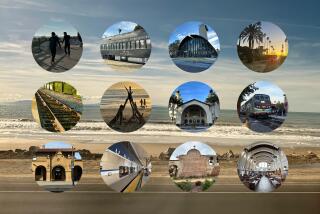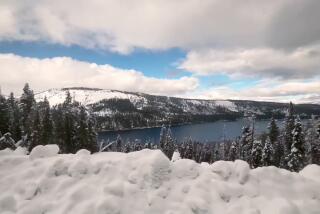‘Train’ lovingly tracks rail travel history
The routes American railroads follow were laid out almost exclusively in the 19th and 20th centuries, when trains were symbols of modernity and industrial power. And today, riding a train — especially in the United States — can feel like stepping into a time machine.
Tom Zoellner enters this time machine again and again in his highly entertaining, lucid and perceptive travelogue “Train: Riding the Rails That Created the Modern World — From the Trans-Siberian to the Southwest Chief.” It’s an account of Zoellner’s travels on six legendary rail lines, but it’s really much more than that: It’s a train lover’s celebration of the great epic story of rail travel itself.
Railroads are a mode of transportation invented, quite by accident, by 18th century Britons trying to keep water out of underground mines. But they have shaped our notions of time and space more than any other technology in human history.
“We live in a society that was made by the railroads in ways we never think about anymore,” writes Zoellner, a Chapman University professor and author of books on topics ranging from uranium to Gabrielle Giffords. We owe to railroads, he says, “our abstract notion of time and our sense of everyday connection with people who may live out of sight but are made neighbors through mechanical means. Under the skin of modernity lies a skeleton of railroad tracks.”
The industry that gave us standardized clocks lives on in the industrial and riverside landscapes where trains run today. With his cinematic eye and encyclopedic rail knowledge, Zoellner shows how you can see that history today, from the windows of an Amtrak passenger car or a Spanish bullet train.
Zoellner begins by taking a ride across Great Britain from the northern tip of Scotland to Land’s End at the southwestern tip of England. Along the way, he sees the places where steam engines first made locomotives run and tells how railways captured the British imagination in the mid-1800s.
One of the first of many subtle cultural shifts trigged by train travel, Zoellner writes, was the “great social embarrassment” of people taking seats in rail cars and finding themselves “suddenly forced to talk with strangers.” From this very British discomfort, a new habit was born — reading on the train — followed by a new business model to get books in the hands of middle-class and affluent passengers. That’s how W.H. Smith and Louis Hachette got their start as booksellers, followed by Allen Lane, who started a publishing house called Penguin to give train riders “quality” fiction and prose.
Zoellner doesn’t do much reading himself as he rides modern-day trains in Britain, India, Peru and Spain. Instead, he engages the random passengers that take seats next to him in conversation. Sometimes, these passages feel like inconsequential small talk.
“Oh, you’re going to like this train,” says the first passenger Zoellner meets, in Pentland Firth, Scotland. “The toilets often freeze over this time of year.”
Zoellner never fails, however, to quickly bring us back to the ongoing story of train travel. They still clack-clack musically across continents and subcontinents.
In India, the trains are a legacy of British imperialism, of course, but have been transformed into a uniquely Indian institution that unifies an ethnically and linguistically diverse country. Just outside of New Delhi, Zoellner crafts a funny and poignant scene at the brick hut that is the workplace of gateman Sita Ram.
Ram’s job is to lower a gate on the trunk line leading into the capital, stropping “all the cars and motorbikes and cows and people” from crossing the tracks until a train passes. For this, he earns $3 a day. “The national system of hand-operated gates is primitive and ponderous, but it all works somehow,” Zoellner writes.
Funny thing: On Zoellner’s next stop he visits one of the most modern countries on Earth. Here, in the U.S., the system is not really working well at all.
Zoellner travels from New York to Chicago, recounting the early, glory days of American railroads. Then he pays $900 for a sleeping berth in a Chicago to Los Angeles train — an outrageous sum for a ride whose speed rarely tops more than 60 mph. The food is all microwaved, but it’s not the cuisine he’s come to enjoy. We see hills leveled and continent spanned from the Pacific to the Atlantic. All sorts of historical figures make unexpected cameos, including George Gershwin, John Cheever and Langston Hughes, who grew up in Midwestern towns, going to stations to watch trains bound for Chicago. And we learn much fascinating rail minutiae. The phrase “rolling out the red carpet,” it turns out, was born a century ago at New York’s Grand Central Station, at the entrance to the 6 p.m. first-class train to Chicago.
After an ill-fated trip to Siberia and a few other places, Zoellner ends back in California, which occasions a brief account of the fight to bring American railroads into the 21st century by constructing a high-speed line across the Golden State. At the top of the Tehachapi Pass he sees the hills that will have to be tunneled to build California’s “project of the century.” Zoellner concedes that not many locals are excited by the idea and writes that “making way for a new railroad was one essential American art form that had fallen out of favor.”
After reading Zoellner’s wonderful account of the past and present of train travel, you too might vote for the next big rail bond. Or you simply might do what L.A. resident Zoellner does regularly: Walk past the gardens at the entrance to Union Station and board a slow-moving train that will take you to another station, near or far.
Train
Riding the Rails That Created the Modern World — from the Trans-Siberian to the Southwest Chief
By Tom Zoellner
Viking: 384 pp., $27.95
More to Read
Sign up for our Book Club newsletter
Get the latest news, events and more from the Los Angeles Times Book Club, and help us get L.A. reading and talking.
You may occasionally receive promotional content from the Los Angeles Times.







